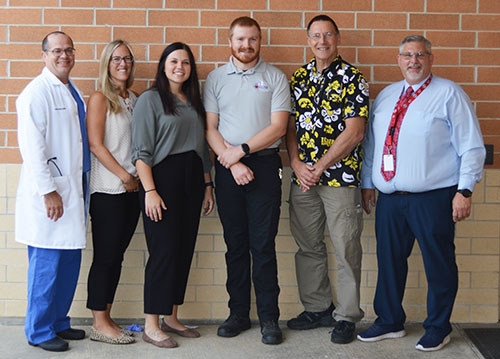You are here
Home ›Recent survey shows positive results for Veterans Memorial Hospital’s ER Department

ER Department continues as highly rated Level IV trauma facility following survey ... The Emergency Department was recently surveyed by five professionals from the Iowa Department of Health and Human Services, Bureau of Emergency Medicine and Trauma Services, who intensely investigated the policies, procedures, and equipment in the department. This verification happens every three years to ensure Veterans Memorial Hospital is meeting the criteria and to offer feedback on what can be done to improve the trauma program. The survey results were very successful with some key take-aways on how to improve the program. Pictured outside of the Veterans Memorial Hospital ER is the team who helped complete the survey, including John Kelly, ER Provider; Jayne McCormick, Chief Nursing Officer; Callie Thorson, ER Supervisor; Jacob Dougherty, EMS Supervisor; Dr. Dave Schwartz; and Michael Coyle, Chief Executive Officer. Submitted photo.
The Emergency Department at Veterans Memorial Hospital in Waukon was recently surveyed by five professionals from the Iowa Department of Health and Human Services, Bureau of Emergency Medicine and Trauma Services, who intensely investigated the policies, procedures and equipment in the department. Callie Thorson, Emergency Room (ER) Supervisor, coordinated the survey with the team members.
To be a level IV trauma facility, there are several criteria that need to be met yearly. This verification happens every three years to ensure Veterans Memorial Hospital is meeting that criteria and to offer feedback on what can be done to improve the trauma program.
“The surveyors asked a number of questions and reviewed all ER policies and procedures to ensure that we are meeting the standards to continue as a level IV trauma facility,” explained Thorson. “We could have chosen to have our survey virtually, but instead we wanted to meet with them personally to really dig into our department to find out how we were doing and what needs improving.”
“The survey team did come on site for the first time in a very long time so they could see our facility. We spent about four hours with them touring the facility, doing chart reviews, explaining how our trauma program works, and then going over the strengths of our program and what we can do to continue to improve,” Thorson said. “One way we are planning to strengthen our trauma team and skills here is to host a Rural Trauma Team Development Course (RTTDC) in October through Gundersen Health System. Gundersen will actually bring about five of their own instructors to our campus to teach us in our own working environment how to improve on care of trauma patients. This is a full-day course that will involve providers, nursing, EMS, lab, radiology, and all others involved in the care of trauma patients.”
Some of the strengths as outlined by the survey team included:
• Callie Thorson’s high level of engagement and eagerness to make improvements to the trauma program are evident. In her short time in the trauma program manager position, she has already identified opportunities for improvement and implemented meaningful changes.
• Dr. McMullan and Dr. Schwartz provide joint medical directorship for several local EMS services, which allows for streamlined care between pre-hospital and hospital patient management.
• The administrative team is a supportive one. The CEO’s background as a flight paramedic provides an active understanding of the importance of the trauma system.
• Maintenance staff’s involvement in trauma alerts and readiness for educational involvement as EMTs to be involved clinically is remarkable.
• The EMS engagement with the facility and trauma program is robust.
• The availability, coverage and participation of anesthesia services at the facility, as well as involvement with trauma alerts, is notable. The willingness of the CRNAs to utilize their clinical backgrounds to educate the team is meaningful.
• There is a good supply of blood products, including FFP, which is a strength for the hemorrhaging patient at a Level IV facility.
• The availability and utilization of Avel eEmergency telehealth services provides additional oversight to the care of injured patients.
• Coordinating low volume, high risk skills and education at monthly meetings is noteworthy.
• The overall engagement with the hospital and community is a strength. Educational and outreach activities are robust.
“We learned so much from their survey and were thrilled with the results,” adds Thorson. “Overall, our survey was very successful with some key takeaways on how to continue to improve our program. We strive to offer top-notch ER care and will continue to do so!”

